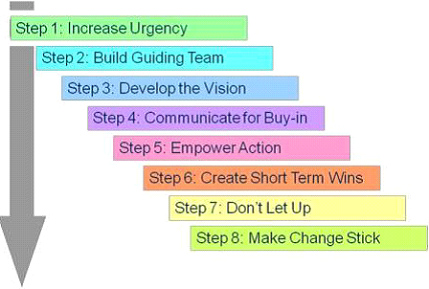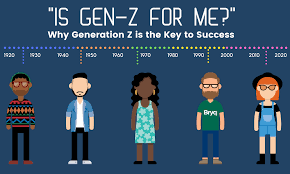With the eight-step Kotter Change Model, management and strategy expert John Kotter has given us one of the best and most practical models for building successful and sustainable organizations over the long term.
In a nutshell, the eight essential steps to planning for and implementing change are:
- Creating a sense of urgency
- Forming a powerful guiding coalition
- Creating a vision
- Communicating the vision
- Empowering others to act on the vision
- Planning for and creating short-term wins
- Consolidating improvements and producing still more change
- Institutionalizing new approaches
You can divide these eight steps into three phases:
- Preparing a climate receptive to change
- Bringing your entire organization on board with change
- Implementing and cementing the desired change
From this perspective, the creation of a vision stands out as the third step in the initial phase, helping you to move into the second phase in which you’ll communicate that vision to a broader group.
You won’t transform your organization without a vision
Creating a vision may sound relatively simple to achieve. Some leaders may feel they can cut corners by breezing through it. For many organizations, however, it’s one of the most challenging steps on the pathway to implementing change.
In articulating that vision, you’ll need to delineate precisely how the future of your organization will be different than its past, and you’ll need to do this in a way that will excite stakeholders at every level and secure their buy-in. This buy-in is key to building out the initiatives and processes that will transform vision into reality.
Tapping into the sense of urgency that’s now empowering your guiding coalition, you’ll create a vision to serve as the foundation for the change to follow. This involves an investment of everyone’s time and energy in debating, negotiating, and forming agreements as you think carefully about what you want to achieve. At this stage, you are figuring out what change looks like. The result will also show you and your team why it’s so important to make that change happen.
The practical results of creating a vision
Kotter notes that a clear and definable vision moves you forward in three important ways. It helps build on the initial sense of urgency, galvanizing people to take the first—sometimes difficult—steps in the needed direction; it serves to guide and calibrate the actions of each key team member to those of the rest of the team; and it provides the foundation for the way you’ll want to frame strategies and make decisions going forward.
When Kotter outlines the characteristics of a well-crafted vision, he focuses on the following:
- Making the vision easy for stakeholders to imagine
- Desirable in the eyes of these stakeholders
- Realistic in terms of its goals
- Clear and easy to follow
- Nimble and responsive to changing conditions
- Simple to summarize
- Easy to explain
You’re looking for an elevator pitch, but one into which you’ve poured a lot of in-depth thinking, strategizing, collaborating, and word-smithing.
It’s not too much to say that a clear, well-articulated, action-oriented vision provides everyone on your team with the sense of meaning you need to keep any change project on track.
The power of sustained communication
Communication is one of the most important aspects of nourishing the vision for the change you want to see. Effective communication is the action that will move you into the second phase, when you are bringing your whole organization on board as change ambassadors, clearing away barriers, and enjoying milestones that mark your progress.
Without effective communication of your vision, you’ll find yourself hard-pressed to gain the buy-in you need to sustain the change. Kotter notes that expert change leaders identify and utilize every type of communication channel available to them. They also take up the mantle of change, remembering what the advertising world knows so well: the value of regular repetition to form habits of thinking and encourage follow-through.
Storytelling should be a key component of the communication of your vision. Personal, relatable stories make abstract concepts like “change” more real. Stories also speak the universal language of emotion, loyalty, and belonging.
Be the vision for the change you want to see
One potential pitfall here is if you yourself fail to be the change. You need to walk the walk and do the work alongside your team, or you won’t get the buy-in you need. Unless you make it clear that you’re doing the necessary work on yourself that you’re asking them to do—and this includes facing up to doubts and uncertainties and expanding your worldview—you risk losing any trust you’ve worked to build up. Morale could plummet, and with it your goal of making lasting, positive change.
As experts in Kotter’s change model have pointed out, change management is ultimately more about influencing people than anything else. For that change to take effect, you and your team at every level of your organization need the power of a vision that will inspire you.
As Kotter himself has said, developing the right vision for your organization is a big step. It requires time, care, and regular, honest communication with multiple people. It is nothing less than “an exercise of both the head and the heart.”



